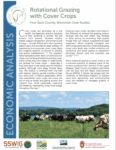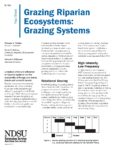The educational materials listed on this page are about Grazing Management.
Grazing management is critical to any pasture-based livestock farming system. Rotational grazing, intensive rotational grazing and management intensive grazing are key to successful and sustainable rotational grazing systems. So, what is rotational grazing? Careful grazing strategies include stocking rates of cattle, time spent on each paddock or pasture, how many times a herd revisits that same paddock or pasture throughout the year, and incorporating multi-species grazing to reduce parasite loads. Management approaches used to increase grazing uniformity, such as water sources and fencing, improve livestock grazing distribution problems. Rotational grazing cattle may also require capital expenditures. Thus, less expensive, practical solutions, like selecting cattle with desirable grazing patterns and culling cattle without, have been suggested as tools for improving managed intensive rotational grazing. This makes a rotational grazing definition difficult to refine depending on geographic location. Key practices include holistic management, grazing management, rotational grazing, livestock breeding, stocking rate, rangeland pasture management, pasture renovation, watering systems, multi-species grazing, continuous grazing.
The Rangeland Management Strategies bulletin has information for multi-species grazing and winter grazing, and it offers advice for forage management and vegetation management, as well as practices for protecting riparian areas. SARE’s Small Ruminant Toolbox offers producers with small ruminant livestock enterprises practices that provide pest, weed and parasite control. Smart Water Use on your Farm or Ranch can be used to better understand the role of water in a farm system and in grazing management.
Showing 1-5 of 5 results
Introduction to Ecological Outcomes Verification: Short-Term Monitoring
This Michigan State University course is designed to teach the foundations of short-term monitoring through the use of Ecological Outcomes Verification (EOV). EOV is a practical and scalable soil and landscape assessment methodology that tracks outcomes in biodiversity, soil health, and ecosystem function (water cycle, mineral cycle, energy flow and community dynamics). EOV applies to […]

Rotational Grazing with Cover Crops Case Studies
Since rotational grazing of cover crops is not a common practice, to address some of the current questions from farmers in the upper Midwest, the Sand County Foundation of Wisconsin partnered with the Sauk Soil and Water Improvement Group and the University of Wisconsin-Madison to explore short-term agronomic and environmental costs and benefits of managed […]

Grazing and Pasture Management
Grazing management is critical to any pasture-based livestock farming system. Practices such as rotational grazing, intensive rotational grazing, and management intensive grazing can be critical to successful and sustainable grazing systems. NCR-SARE has supported research and educational opportunities around the topic of grazing and pasture management in order to help producers reduce costs and increase profits.

Maintenance of Natural Sustainable Riparian Communities Fact Sheets Series
A graduate student from North Dakota State University created these five extension fact sheets after monitoring and reporting on the riparian ecosystem associated with the Middle Sheyenne River, a perennial stream in eastern North Dakota.

Poultry Your Way
Poultry Your Way is for anyone interested in commercially raising, processing, and marketing poultry. It is designed to help you consider alternatives, and to help you make decisions about which alternative(s) will be most compatible with your family and business goals.